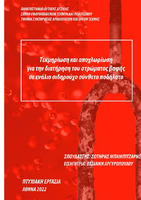| dc.contributor.advisor | ARGYROPOULOS, VASILIKE | |
| dc.contributor.author | Μπαμπιτζάρης, Σωτήριος | |
| dc.date.accessioned | 2023-06-21T07:06:09Z | |
| dc.date.available | 2023-06-21T07:06:09Z | |
| dc.date.issued | 2022-09-26 | |
| dc.identifier.uri | https://polynoe.lib.uniwa.gr/xmlui/handle/11400/4522 | |
| dc.identifier.uri | http://dx.doi.org/10.26265/polynoe-4360 | |
| dc.description.abstract | Η παρούσα πτυχιακή εργασία αφορά την μελέτη ενός ενάλιου σύνθετου μεταλλικού
ποδηλάτου με την παρουσία ιόντων χλωρίου. Το ποδήλατο εκτιμάται ότι κατασκευάστηκε
στις αρχές της δεκαετίας του 90 και βρέθηκε στον πυθμένα του λιμανιού των Φούρνων
Κορσέων Το ποδήλατο αποτελείται από έναν μεταλλικό σκελετό από κράμα σιδήρου και
φέρει στοιχεία από πλαστικό και καουτσούκ, καθώς επίσης και στρώση βαφής κόκκινου
χρώματος και λευκού. Για να γίνει καταγραφή, ταυτοποίηση των υλικών και εύρεση της
τεχνολογίας κατασκευής έγινε χρήση καταστρεπτικών μεθόδων ανάλυσης με απόσπαση
δειγμάτων. Οι τεχνικές που χρησιμοποιήθηκαν είναι η ηλεκτρονική μικροσκοπία με
στοιχειακή ανάλυση (SEM/EDX) και η υπέρυθρη φασματοσκοπία (FTIR).
Στα σύνθετα μεταλλικά αντικείμενα με ενεργή διάβρωση είναι δύσκολη η εφαρμογή κάποιας
τεχνικής αφαίρεσης των ιόντων χλωρίου λόγο των διαλυμάτων με αλκαλικό pH που
χρησιμοποιείται συνήθως. Αυτό φέρει προκλήσεις στην ορθή συντήρηση ενός αντικειμένου
σαν αυτό της έρευνας μας γιατί υπάρχει μεγάλη πιθανότητα απώλειας οργανικού υλικού και
βαφής. Γι’ αυτό λαμβάνοντας υπόψιν την παρουσία ιόντων χλωρίου θα εφαρμοστεί μια
τεχνική ηλεκτρόλυσης με ηλεκτρολύτη σε ουδέτερο pH για την διάσωση της χρωστικής
επιφάνειας. O ηλεκτρολύτης που θα εφαρμοστεί είναι ένα διάλυμα Νιτρικού Καλίου ΚΝΟ₃.
Το συμπέρασμα από αυτή την διαδικασία εφαρμογής της ηλεκτρόλυσης είναι η ανάγκη
έρευνας της εφαρμογής αυτής και η διεύρυνση νεών εφαρμογών για την αντιμετώπιση των
σύνθετων τεχνεργών | el |
| dc.format.extent | 38 | el |
| dc.language.iso | el | el |
| dc.publisher | Πανεπιστήμιο Δυτικής Αττικής | el |
| dc.rights | Αναφορά Δημιουργού - Μη Εμπορική Χρήση - Παρόμοια Διανομή 4.0 Διεθνές | * |
| dc.rights.uri | https://creativecommons.org/licenses/by-nc-sa/4.0/deed.el | * |
| dc.subject | Ενάλιο | el |
| dc.subject | Αποχλωρίωση | el |
| dc.subject | SEM | el |
| dc.subject | FTIR | el |
| dc.subject | Συντήρηση | el |
| dc.subject | Ποδήλατο | el |
| dc.title | Τεκμηρίωση και αποχλωρίωση για την διατήρηση του στρώματος βαφής σε ενάλιο σιδηρούχο ποδήλατο | el |
| dc.title.alternative | Documentation and dechlorination for the preservation of the painted layer to a waterlogged iron bike | el |
| dc.type | Πτυχιακή εργασία | el |
| dc.contributor.committee | ARGYROPOULOS, VASILIKE | |
| dc.contributor.committee | Γιαννουλάκη, Μαρία | |
| dc.contributor.committee | Φακορέλλης, Γεώργιος | |
| dc.contributor.faculty | Σχολή Εφαρμοσμένων Τεχνών & Πολιτισμού | el |
| dc.contributor.department | Τμήμα Συντήρησης Αρχαιοτήτων και Έργων Τέχνης | el |
| dc.description.abstracttranslated | This dissertation studies a waterlogged composite metal bike with the appearance of chloride
ions. The bike was manufactured at the beginning of the 90s decade and it was found at the
seabed of the port of Fourni Korseon. The bike is composed of a metal skeleton from an iron
alloy and it has components from plastic, rubber and also a painted layer of red and white
color. In order to document and substantiate of the materials and also discover the
manufacturing technology the use of destructive methods for analysis was necessary with the
detachment of samples. The methods that were carried out were the use of electron
microscopy (SEM/EDX) and the use of infrared spectroscopy (FTIR).
Composite metal objects with active corrosion have a difficult application of an ion chloride
removal method due to the alkaline solutions that is common to use. This brings new
challenges to the right conservation methods used on an object such as the one of our
research because of the big chance of losing organic material and paint. That is why, taken
consideration of the chloride ions, the use of an electrolysis method will take place with an
electrolyte of neutral pH in order to salvage the painted layer. The electrolyte being used is
potassium nitrate ΚΝΟ₃. The conclusion of the method used is the need of research on this
method and the further expansion to new methods for the challenge of composite artifacts. | el |


